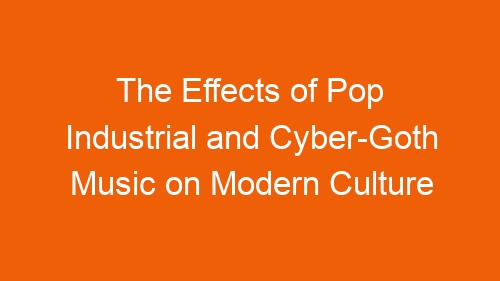-
Table of Contents
The Influence of Pop Industrial Music on Fashion Trends
Pop industrial music and cyber-goth music have had a significant impact on modern culture, particularly in the realm of fashion. These genres of music have inspired unique and edgy fashion trends that have become increasingly popular in recent years. From bold colors and futuristic designs to unconventional accessories and makeup, the influence of pop industrial and cyber-goth music can be seen in a variety of fashion styles.
One of the key elements of pop industrial and cyber-goth fashion is the use of bold and unconventional colors. Bright neon hues, metallic shades, and dark, moody tones are often incorporated into clothing and accessories to create a striking and eye-catching look. These colors are often paired with edgy and futuristic designs, such as asymmetrical cuts, geometric patterns, and avant-garde silhouettes. The result is a fashion style that is both bold and unconventional, reflecting the rebellious and non-conformist attitude of pop industrial and cyber-goth music.
In addition to bold colors and futuristic designs, pop industrial and cyber-goth fashion also often incorporates unconventional accessories and makeup. Accessories such as spiked jewelry, platform boots, and statement sunglasses are commonly seen in these fashion styles, adding an extra edge to the overall look. Makeup is also an important aspect of pop industrial and cyber-goth fashion, with dark, dramatic eye makeup, bold lip colors, and intricate face paint often being used to create a striking and otherworldly appearance.
The influence of pop industrial and cyber-goth music on fashion trends can be seen in a variety of different styles, from streetwear and clubwear to high fashion and avant-garde couture. Designers and fashion brands have been increasingly incorporating elements of pop industrial and cyber-goth fashion into their collections, resulting in a growing trend towards edgy and unconventional styles in the fashion industry.
One of the reasons why pop industrial and cyber-goth fashion has become so popular in recent years is its ability to push boundaries and challenge traditional notions of beauty and style. By embracing bold colors, unconventional designs, and edgy accessories, pop industrial and cyber-goth fashion allows individuals to express themselves in a unique and creative way. This sense of freedom and self-expression has resonated with many people, particularly younger generations who are looking for ways to stand out and make a statement in a world that often feels homogenous and conformist.
Overall, the influence of pop industrial and cyber-goth music on fashion trends has been significant and far-reaching. From bold colors and futuristic designs to unconventional accessories and makeup, the edgy and rebellious spirit of these music genres can be seen in a variety of fashion styles. By embracing these trends, individuals are able to express themselves in a unique and creative way, pushing boundaries and challenging traditional notions of beauty and style. As pop industrial and cyber-goth music continue to evolve and grow in popularity, it is likely that their influence on fashion trends will only continue to grow in the years to come.
Cyber-Goth Music and Its Impact on Visual Arts
Pop industrial and cyber-goth music have had a significant impact on modern culture, influencing not only the music industry but also visual arts. Cyber-goth music, in particular, has inspired artists to create visually striking and futuristic works that reflect the themes and aesthetics of the genre.
One of the key ways in which cyber-goth music has influenced visual arts is through its emphasis on technology and the digital world. The music often features electronic sounds and futuristic themes, which have inspired artists to incorporate similar elements into their work. This can be seen in the use of digital art techniques, such as 3D modeling and animation, to create visually stunning and immersive pieces that capture the essence of cyber-goth music.
Furthermore, cyber-goth music has also influenced the visual aesthetics of art installations and performances. Artists have drawn inspiration from the bold and edgy style of cyber-goth music, incorporating elements such as neon lights, metallic textures, and industrial materials into their work. This has resulted in visually striking and immersive experiences that blur the lines between music, art, and technology.
In addition to influencing the visual aesthetics of art, cyber-goth music has also inspired artists to explore themes of identity, technology, and the future in their work. The music often addresses issues such as the impact of technology on society, the blurring of boundaries between human and machine, and the quest for self-expression in a digital age. Artists have drawn on these themes to create thought-provoking and visually engaging pieces that challenge traditional notions of art and culture.
Overall, cyber-goth music has had a profound impact on visual arts, inspiring artists to create visually striking and immersive works that reflect the themes and aesthetics of the genre. By incorporating elements of technology, futurism, and identity into their work, artists have been able to push the boundaries of traditional art forms and create new and exciting experiences for audiences.
In conclusion, the effects of pop industrial and cyber-goth music on modern culture are undeniable. From influencing the music industry to inspiring visual artists to create bold and innovative works, these genres have left a lasting impact on the cultural landscape. As technology continues to advance and society becomes increasingly digital, it is likely that the influence of cyber-goth music on visual arts will only continue to grow, shaping the way we experience and interact with art in the future.
Industrial Music’s Role in Shaping Subcultures in Modern Society
Industrial music has long been a driving force in shaping subcultures within modern society. With its roots in the late 1970s and early 1980s, industrial music emerged as a genre that blended elements of punk rock, electronic music, and avant-garde experimentation. Bands like Throbbing Gristle, Cabaret Voltaire, and Einstürzende Neubauten paved the way for a new wave of artists who would push the boundaries of music and culture.
One of the key characteristics of industrial music is its use of harsh, abrasive sounds and themes that challenge societal norms. This rebellious spirit has resonated with many individuals who feel alienated or marginalized by mainstream culture. As a result, industrial music has become a rallying point for those who seek to express their discontent with the status quo.
The influence of industrial music can be seen in a variety of subcultures that have emerged over the years. From goth and punk to cyber and steampunk, industrial music has provided a soundtrack for those who embrace alternative lifestyles and ideologies. These subcultures often incorporate elements of industrial music into their fashion, art, and overall aesthetic, creating a sense of unity and belonging among like-minded individuals.
In addition to shaping subcultures, industrial music has also had a significant impact on mainstream culture. Artists like Nine Inch Nails, Marilyn Manson, and Ministry have achieved commercial success while staying true to the industrial ethos. Their music has reached a wide audience, introducing many people to the sounds and ideas of industrial music.
Furthermore, industrial music has influenced other genres, such as electronic dance music and metal. The industrial sound can be heard in the heavy beats and distorted guitars of many contemporary artists, demonstrating the lasting impact of this genre on the musical landscape.
As technology has advanced, industrial music has evolved to incorporate new sounds and techniques. The rise of cyber-goth music, a subgenre that combines industrial music with elements of cyberpunk and gothic aesthetics, has further expanded the reach of industrial music. Bands like Grendel, Aesthetic Perfection, and Combichrist have embraced this fusion of styles, creating a unique sound that appeals to a diverse audience.
The rise of cyber-goth music has also had a visual impact on modern culture. The futuristic, dystopian imagery associated with cyber-goth fashion and art has influenced everything from fashion design to film and television. This aesthetic has become a popular choice for those who seek to express their individuality and creativity in a world that often values conformity.
In conclusion, industrial music has played a crucial role in shaping subcultures and influencing mainstream culture. Its rebellious spirit and innovative sound have inspired generations of artists and fans to push the boundaries of music and art. As cyber-goth music continues to gain popularity, the influence of industrial music on modern culture is likely to grow even stronger. Whether you’re a die-hard fan or a casual listener, it’s clear that industrial music has left a lasting mark on the cultural landscape.




















